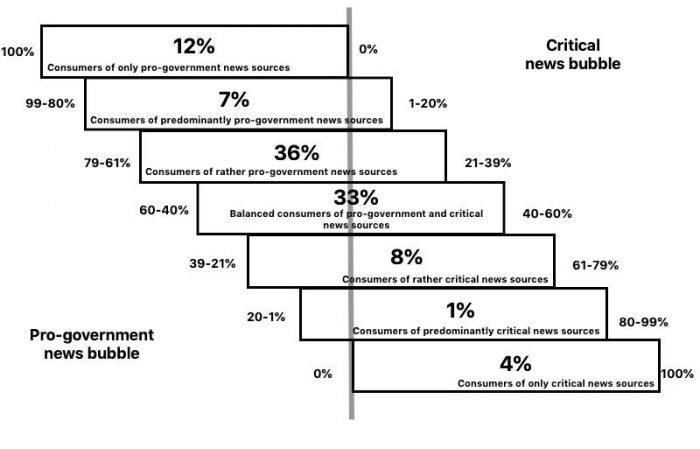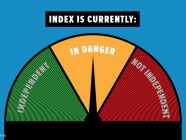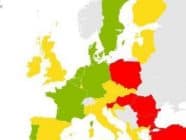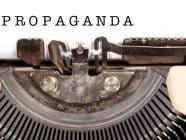Hungarians who inhabit the pro-government “news bubble” are rarely exposed to government-critical viewpoints.
There has long been a sharp division in the Hungarian media between pro-government and government-critical camps. Since it came to power in 2010, the national-conservative Fidesz party has regularly insisted that the Hungarian media are characterised by a pronounced left-liberal bias.
However, Fidesz’s claims of the dominance of left-liberal media are directly contradicted by a study carried out early in 2019 by Mérték Media Monitor and the public opinion research company Medián. This study found that Hungarians consume far more news produced by pro-government media outlets than they do news disseminated by independent media outlets.
Not only that, but an overwhelming majority gets its information exclusively from pro-government news sources.
Government-friendly conglomerate
The establishment of the Central European Press and Media Foundation (generally known by its Hungarian abbreviation of KESMA) late in 2018 and its dominant market position gave renewed impetus to the debate over which part of the political spectrum is more prominent in the Hungarian media.
The creation of KESMA produced a huge conglomerate encompassing most government-friendly media companies. The Mérték study found that, based on 2017 revenues, the companies that subsequently became part of KESMA had a market share of 38.8 percent in the news and political content sector. However, if we add to this group other media outlets that are not officially part of KESMA but are still indisputably close to Fidesz (such as the daily Magyar Hírlap and the weekly Demokrata, as well as media formerly owned by the state film commissioner Andrew Vajna, who died in January 2019), then the proportion of the market occupied by government-friendly media is 77.8 percent. This means that media not connected in some way to the government have access to only 22.2 percent of the available media market resources.
News consumption patterns
In addition to the study of market share, Mérték and Medián also conduct regular surveys of news consumption patterns in Hungary, which seek to establish the main sources Hungarians use to inform themselves about political issues. The most recent survey looked at the extent to which news consumers are confined to “news bubbles” corresponding to which part of the political spectrum they identify with.
For this survey, 1,200 adults were interviewed, of whom 94 percent came into the category of regular news consumers (in other words, those who regularly consume at least one news source). Within this category, news users consume an average of five news sources.
Political divide
Once the news media consumed on a regular basis by each interviewee had been identified, these were divided into pro-government and government-critical categories.
A clear connection between party preference and the consumption of particular media outlets quickly emerged. The ownership background was the main determining factor here, with a large proportion of pro-government media belonging to the group that has since late 2018 been part of KESMA.
The ownership background was also an important factor in determining the political allegiance of other media. In the few cases where there was no unequivocal connection between a media outlet and one side of the political divide or another, our categorisation was based on what we already knew about the background of the outlet and the nature of the content produced by it. A few of the outlets that we categorised in this way received a neutral/balanced classification and were taken into account on both sides of the model.
Seven types of consumer
After assigning the media outlets to the various categories, we looked at the proportions in which consumers obtain information from news sources affiliated to both sides of the political divide – in other words, which percentage of the news they consumed on a regular basis came from pro-government sources and which from critical sources.
Based on these percentages, we were able to assign the regular news consumers to seven clearly differentiated groups (see chart below).

At the opposite extremes are those who get their news only from pro-government media outlets and those who inform themselves only by reading critical news sources. In between are those who consume either predominantly pro-government or predominantly government-critical media outlets and those who consume media that tend to be either rather pro-government or rather government-critical. Finally, halfway along the spectrum is a group of people who get their information from roughly the same number of pro-government and government-critical sources.
Unbalanced spectrum
The two sides of the chart clearly demonstrate the extent to which consumers of pro-government media outweigh consumers of government-critical media. Though there is a “balanced” group in the middle consisting of 33 percent of regular news consumers, the total of those on the left-hand side of the chart far exceeds those on the right-hand side of the chart.
At the opposite ends of the spectrum, the chart shows that the proportion of those who get their information only from pro-government news sources (12 percent) is much higher than the proportion of those who only consume critical news sources (4 percent).
This pro-government “news bubble” suggests that around 12 percent of the Hungarian electorate is never exposed to critical viewpoints in the media – a situation that has serious implications for the future of media pluralism in the country.
This is an abridged version of an article that first appeared in Hungarian on the Mérték website and subsequently also on EJO’s Hungarian-language site. Translation by Annamária Torbó.
Image source: Max Pixel / Licenced under CC0 1.0 Universal
If you liked this story, you may also be interested in Simple Yet Sophisticated: How Hungary’s Pro-Government Media Use Images
Sign up for the EJO’s regular monthly newsletter or follow us on Facebook and Twitter.
Tags: consolidation of ownership, Fidesz, filter bubbles, KESMA, Media Pluralism, Medián, Mértek Média Monitor, news consumption patterns














































